[English] 日本語
 Yorodumi
Yorodumi- PDB-7sge: I53-50 nanoparticle core reconstructed from GPC-I53-50NP by focus... -
+ Open data
Open data
- Basic information
Basic information
| Entry | Database: PDB / ID: 7sge | ||||||
|---|---|---|---|---|---|---|---|
| Title | I53-50 nanoparticle core reconstructed from GPC-I53-50NP by focused refinement | ||||||
 Components Components |
| ||||||
 Keywords Keywords | VIRAL PROTEIN / glycoprotein / Lassa / Josiah / vaccine design / nanoparticle / protein design | ||||||
| Biological species | synthetic construct (others) | ||||||
| Method | ELECTRON MICROSCOPY / single particle reconstruction / cryo EM / Resolution: 3.67 Å | ||||||
 Authors Authors | Antanasijevic, A. / Brouwer, P.J.M. / Ward, A.B. | ||||||
| Funding support |  United States, 1items United States, 1items
| ||||||
 Citation Citation |  Journal: Cell Host Microbe / Year: 2022 Journal: Cell Host Microbe / Year: 2022Title: Lassa virus glycoprotein nanoparticles elicit neutralizing antibody responses and protection. Authors: Philip J M Brouwer / Aleksandar Antanasijevic / Adam J Ronk / Helena Müller-Kräuter / Yasunori Watanabe / Mathieu Claireaux / Hailee R Perrett / Tom P L Bijl / Marloes Grobben / Jeffrey C ...Authors: Philip J M Brouwer / Aleksandar Antanasijevic / Adam J Ronk / Helena Müller-Kräuter / Yasunori Watanabe / Mathieu Claireaux / Hailee R Perrett / Tom P L Bijl / Marloes Grobben / Jeffrey C Umotoy / Angela I Schriek / Judith A Burger / Khadija Tejjani / Nicole M Lloyd / Thijs H Steijaert / Marlies M van Haaren / Kwinten Sliepen / Steven W de Taeye / Marit J van Gils / Max Crispin / Thomas Strecker / Alexander Bukreyev / Andrew B Ward / Rogier W Sanders /     Abstract: The Lassa virus is endemic in parts of West Africa, and it causes hemorrhagic fever with high mortality. The development of a recombinant protein vaccine has been hampered by the instability of ...The Lassa virus is endemic in parts of West Africa, and it causes hemorrhagic fever with high mortality. The development of a recombinant protein vaccine has been hampered by the instability of soluble Lassa virus glycoprotein complex (GPC) trimers, which disassemble into monomeric subunits after expression. Here, we use two-component protein nanoparticles consisting of trimeric and pentameric subunits to stabilize GPC in a trimeric conformation. These GPC nanoparticles present twenty prefusion GPC trimers on the surface of an icosahedral particle. Cryo-EM studies of GPC nanoparticles demonstrated a well-ordered structure and yielded a high-resolution structure of an unliganded GPC. These nanoparticles induced potent humoral immune responses in rabbits and protective immunity against the lethal Lassa virus challenge in guinea pigs. Additionally, we isolated a neutralizing antibody that mapped to the putative receptor-binding site, revealing a previously undefined site of vulnerability. Collectively, these findings offer potential approaches to vaccine and therapeutic design for the Lassa virus. | ||||||
| History |
|
- Structure visualization
Structure visualization
| Structure viewer | Molecule:  Molmil Molmil Jmol/JSmol Jmol/JSmol |
|---|
- Downloads & links
Downloads & links
- Download
Download
| PDBx/mmCIF format |  7sge.cif.gz 7sge.cif.gz | 91 KB | Display |  PDBx/mmCIF format PDBx/mmCIF format |
|---|---|---|---|---|
| PDB format |  pdb7sge.ent.gz pdb7sge.ent.gz | 61.4 KB | Display |  PDB format PDB format |
| PDBx/mmJSON format |  7sge.json.gz 7sge.json.gz | Tree view |  PDBx/mmJSON format PDBx/mmJSON format | |
| Others |  Other downloads Other downloads |
-Validation report
| Summary document |  7sge_validation.pdf.gz 7sge_validation.pdf.gz | 1.3 MB | Display |  wwPDB validaton report wwPDB validaton report |
|---|---|---|---|---|
| Full document |  7sge_full_validation.pdf.gz 7sge_full_validation.pdf.gz | 1.3 MB | Display | |
| Data in XML |  7sge_validation.xml.gz 7sge_validation.xml.gz | 36.1 KB | Display | |
| Data in CIF |  7sge_validation.cif.gz 7sge_validation.cif.gz | 50.8 KB | Display | |
| Arichive directory |  https://data.pdbj.org/pub/pdb/validation_reports/sg/7sge https://data.pdbj.org/pub/pdb/validation_reports/sg/7sge ftp://data.pdbj.org/pub/pdb/validation_reports/sg/7sge ftp://data.pdbj.org/pub/pdb/validation_reports/sg/7sge | HTTPS FTP |
-Related structure data
| Related structure data |  25108MC 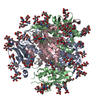 7sgdC 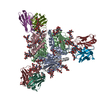 7sgfC M: map data used to model this data C: citing same article ( |
|---|
- Links
Links
- Assembly
Assembly
| Deposited unit | 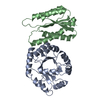
|
|---|---|
| 1 | x 60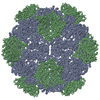
|
| 2 |
|
| 3 | x 5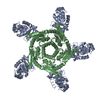
|
| 4 | x 6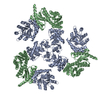
|
| 5 | 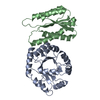
|
| Symmetry | Point symmetry: (Schoenflies symbol: I (icosahedral)) |
- Components
Components
| #1: Protein | Mass: 73845.570 Da / Num. of mol.: 1 Source method: isolated from a genetically manipulated source Details: De novo designed / Source: (gene. exp.) synthetic construct (others) / Plasmid: pPPI4 / Cell line (production host): HEK293F / Production host:  Homo sapiens (human) Homo sapiens (human) |
|---|---|
| #2: Protein | Mass: 18236.877 Da / Num. of mol.: 1 Source method: isolated from a genetically manipulated source Source: (gene. exp.) synthetic construct (others) / Plasmid: pET28b / Production host:  |
| Has protein modification | Y |
-Experimental details
-Experiment
| Experiment | Method: ELECTRON MICROSCOPY |
|---|---|
| EM experiment | Aggregation state: PARTICLE / 3D reconstruction method: single particle reconstruction |
- Sample preparation
Sample preparation
| Component | Name: I53-50 nanoparticle core recovered from GPC-I53-50 nanoparticle Type: COMPLEX Details: Nanoparticle consists of 60 monomeric I53-50A and 60 monomeric I53-50B building blocks. Nanoparticle was assembled by combining equimolar amounts of GPC-I53-50A and I53-50B. Entity ID: all / Source: RECOMBINANT | |||||||||||||||
|---|---|---|---|---|---|---|---|---|---|---|---|---|---|---|---|---|
| Molecular weight | Experimental value: NO | |||||||||||||||
| Source (natural) | Organism: synthetic construct (others) | |||||||||||||||
| Source (recombinant) | Organism:  Homo sapiens (human) / Cell: HEK293F Homo sapiens (human) / Cell: HEK293F | |||||||||||||||
| Buffer solution | pH: 7 / Details: TBS | |||||||||||||||
| Buffer component |
| |||||||||||||||
| Specimen | Conc.: 2 mg/ml / Embedding applied: NO / Shadowing applied: NO / Staining applied: NO / Vitrification applied: YES Details: I53-50 nanoparticle core recovered from GPC-I53-50 nanoparticle by focused refinement of the core. Nanoparticle was assembled by combining equimolar amounts of GPC-I53-50A and I53-50B. | |||||||||||||||
| Specimen support | Grid material: COPPER / Grid mesh size: 400 divisions/in. / Grid type: Quantifoil R2/1 | |||||||||||||||
| Vitrification | Instrument: FEI VITROBOT MARK IV / Cryogen name: ETHANE / Humidity: 100 % / Chamber temperature: 283 K / Details: Blot time 4s, Wait time 10s, Blot force 0 |
- Electron microscopy imaging
Electron microscopy imaging
| Experimental equipment |  Model: Titan Krios / Image courtesy: FEI Company |
|---|---|
| Microscopy | Model: FEI TITAN KRIOS |
| Electron gun | Electron source:  FIELD EMISSION GUN / Accelerating voltage: 300 kV / Illumination mode: FLOOD BEAM FIELD EMISSION GUN / Accelerating voltage: 300 kV / Illumination mode: FLOOD BEAM |
| Electron lens | Mode: BRIGHT FIELD / Nominal magnification: 29000 X / Nominal defocus max: 1600 nm / Nominal defocus min: 600 nm / Cs: 2.7 mm / Alignment procedure: COMA FREE |
| Specimen holder | Cryogen: NITROGEN / Specimen holder model: FEI TITAN KRIOS AUTOGRID HOLDER |
| Image recording | Average exposure time: 10.5 sec. / Electron dose: 50.4 e/Å2 / Detector mode: COUNTING / Film or detector model: GATAN K2 SUMMIT (4k x 4k) / Num. of grids imaged: 2 / Num. of real images: 2337 |
| Image scans | Movie frames/image: 42 |
- Processing
Processing
| EM software |
| ||||||||||||||||||||||||||||||||||||||||||||
|---|---|---|---|---|---|---|---|---|---|---|---|---|---|---|---|---|---|---|---|---|---|---|---|---|---|---|---|---|---|---|---|---|---|---|---|---|---|---|---|---|---|---|---|---|---|
| CTF correction | Type: PHASE FLIPPING AND AMPLITUDE CORRECTION | ||||||||||||||||||||||||||||||||||||||||||||
| Particle selection | Num. of particles selected: 145508 / Details: Template picker | ||||||||||||||||||||||||||||||||||||||||||||
| Symmetry | Point symmetry: I (icosahedral) | ||||||||||||||||||||||||||||||||||||||||||||
| 3D reconstruction | Resolution: 3.67 Å / Resolution method: FSC 0.143 CUT-OFF / Num. of particles: 86411 / Algorithm: BACK PROJECTION Details: Icosahedral symmetry imposed for refinement. Solvent mask around the nanoparticle core used for refinement. Num. of class averages: 1 / Symmetry type: POINT | ||||||||||||||||||||||||||||||||||||||||||||
| Atomic model building | Protocol: RIGID BODY FIT / Space: REAL | ||||||||||||||||||||||||||||||||||||||||||||
| Atomic model building | PDB-ID: 6P6F Accession code: 6P6F / Source name: PDB / Type: experimental model |
 Movie
Movie Controller
Controller




 PDBj
PDBj

